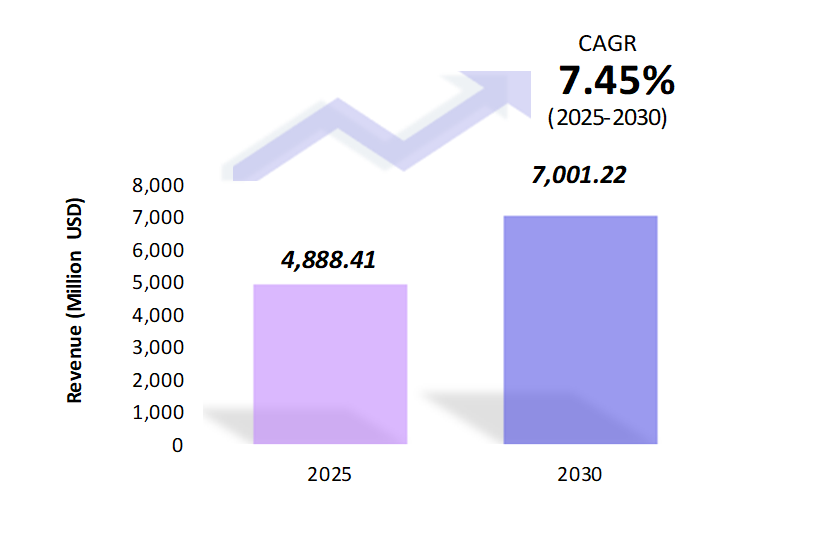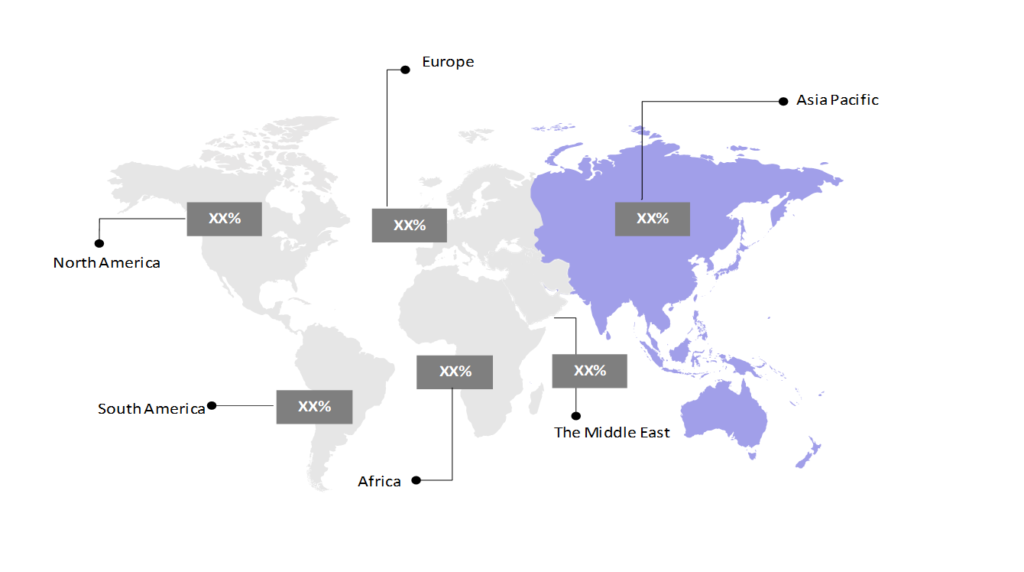Electronic Wet Chemicals Market: Size, Share, Trends & Forecast (2024-2029)
The market report offers a detailed analysis segmented by Form (Liquid Form, Gas Form, Solid Form); by Application (Semiconductor, Integrated circuit (IC) Packaging, Printed Circuit Board PCB); by Geography (North America, South America, Asia Pacific, Europe, The Middle East, Africa).
Outlook

- The electronic wet chemicals market is estimated to be at USD 4,888.41 Mn in 2025 and is anticipated to reach USD 7,001.22 Mn in 2030.
- The electronic wet chemicals market is registering a CAGR of 7.45% during the forecast period 2025-2030.
- The Electronic Wet Chemical Market is driven by the rapid advancement of semiconductor technologies, including artificial intelligence (AI), 5G, and the Internet of Things (IoT), which require ultra-pure chemicals for manufacturing processes. Increased demand for semiconductors and hydrogen peroxide in chip fabrication is propelling market growth, while cloud storage adoption and regulatory pressures pose challenges. Companies are also facing rising costs due to stringent quality requirements for ultra-pure chemicals. Despite these hurdles, the market remains essential to the evolving electronics industry, particularly in advanced chip production.
Request a free sample.
Ecosystem

- The participants in the global electronic wet chemicals industry are always developing their strategies to preserve a competitive advantage.
- The competitive landscape is shaped by frequent mergers, acquisitions, and partnerships as companies seek to expand their market share and technological capabilities. For example, Entegris’ acquisition of BASF’s Precision Microchemical business highlights ongoing consolidation aimed at enhancing portfolios and meeting the sophisticated needs of the semiconductor industry.
- Several important entities in the electronic wet chemicals market include Eastman Chemical Co.; Avantor, Inc.; BASF Group; Honeywell International Inc.; Kanto Chemical Co., Inc.; and others.
Ask for customization.
Findings
| Attributes | Values |
|---|---|
| Historical Period | 2019-2023 |
| Base Year | 2024 |
| Forecast Period | 2025-2030 |
| Market Size (2025) | USD 4,888.41 Mn |
| Market Size (2030) | USD 7,001.22 Mn |
| Growth Rate | 7.45% CAGR from 2025 to 2030 |
| Key Segments | Form (Liquid Form, Solid Form, Gas Form); Application (Semiconductor, IC Packaging, PCB); Geography (North America, South America, Asia Pacific, Europe, The Middle East, Africa) |
| Key Vendors | Eastman Chemical Co.; Avantor, Inc.; BASF Group; Honeywell International Inc.; Kanto Chemical Co., Inc. |
| Key Countries | The US; Canada; Mexico; Brazil; Argentina; China; India; South Korea; The UK; Germany; Belgium; Turkey; UAE; Saudi Arabia; Egypt; South Africa |
| Largest Market | Asia Pacific |
Get a free quote.
Trends
- High-Purity Chemicals for Semiconductor Fabrication: Manufacturers are producing ultra-high purity (UHP) electronic wet chemicals, which are critical for advanced semiconductor processes like EUV lithography. These chemicals reduce contamination, improving yields in smaller nodes such as 5 nm and below.
- Innovative Cleaning Solutions: New formulations of electronic wet chemicals are being developed to meet the stringent cleaning requirements of complex semiconductor devices, including 3D NAND and FinFET architectures. For instance, hydrogen peroxide mixtures are optimized for oxide removal while minimizing damage to delicate layers in advanced ICs.
- Eco-Friendly Chemical Processes: Sustainability is a focus, with companies innovating green chemical solutions that reduce the environmental impact of semiconductor manufacturing. Eco-friendly etchants and cleaning agents, which lower water and energy consumption, are being developed by firms such as Avantor and Entegris.
Speak to analyst.
Catalysts
- Technological Advancements in the Electronics Industry: Rapid advancements in the electronics industry, such as 5G infrastructure, artificial intelligence (AI), and IoT devices, are driving demand for high-performance semiconductors and integrated circuits. This, in turn, boosts the demand for electronic wet chemicals used in processes like etching, cleaning, and chemical-mechanical planarization (CMP).
- Increasing Use of Semiconductors and Integrated Chips: The proliferation of consumer electronics, electric vehicles (EVs), and industrial automation is leading to a surge in the use of semiconductors and integrated circuits. These components require precise chemical treatments in their manufacturing process. Companies like Intel and TSMC rely heavily on wet chemicals such as sulfuric acid and ammonium hydroxide for wafer cleaning and surface preparation in the production of advanced processors for applications like autonomous driving systems.
- Rise in Demand for Hydrogen Peroxide in the Semiconductor Industry: Hydrogen peroxide is increasingly in demand for its critical role in semiconductor fabrication, particularly in cleaning and etching processes. It is used in combination with sulfuric acid in the “piranha solution” to remove organic contaminants from silicon wafers. The expansion of fabs by semiconductor companies such as Samsung in Texas and TSMC in Arizona reflects the growing consumption of hydrogen peroxide as part of the semiconductor manufacturing process. This is essential in ensuring the purity and performance of chips used in high-tech applications like 5G and AI.
Inquire before buying.
Restraints
- Rapid decline in certain technologies due to cloud storage adoption: The shift to cloud-based storage and computing solutions is reducing the demand for certain hardware components, such as traditional hard drives and physical data storage devices. This decline impacts the need for associated electronic wet chemicals used in the manufacturing of these components, including etching and cleaning chemicals. For instance, as companies like Google and Amazon invest in large-scale data centers powered by cloud storage, the focus moves away from physical devices, diminishing the need for chemicals in their production.
- Stringent Health and Environmental Regulations for Certain Chemicals: Governments worldwide are enforcing stricter health and environmental regulations on the use of hazardous chemicals, such as sulfuric acid and hydrofluoric acid, which are commonly used in semiconductor manufacturing. The European Union’s REACH regulation and the US Environmental Protection Agency (EPA) have increased scrutiny on the handling and disposal of these chemicals, which is raising compliance costs for manufacturers. Companies must continually innovate to develop safer alternatives.
- High Costs Associated with Ultra-Pure Chemical Production: The production of ultra-high purity (UHP) chemicals, which are critical for advanced semiconductor manufacturing processes, involves complex purification techniques and stringent quality control measures. As semiconductor technology evolves to smaller nodes (e.g., 3 nm and below), the requirements for chemical purity become even more demanding. This leads to increased production costs for chemical manufacturers.
Personalize this research.
Hotspot

Explore purchase options.
Table of Contents
| 1. Introduction 1.1. Research Methodology 1.2. Scope of the Study 2. Market Overview / Executive Summary 2.1. Global Electronic Wet Chemicals Market (2019 – 2023) 2.2. Global Electronic Wet Chemicals Market (2024 – 2030) 3. Market Segmentation 3.1. Global Electronic Wet Chemicals Market by Form 3.1.1. Liquid Form 3.1.2. Gas Form 3.1.3. Solid Form 3.2. Global Electronic Wet Chemicals Market by Application 3.2.1. Semiconductor 3.2.2. IC Packaging 3.2.3. PCB 4. Regional Segmentation 4.1. North America 4.1.1. The US 4.1.2. Canada 4.1.3. Mexico 4.2. South America 4.2.1. Brazil 4.2.2. Argentina 4.2.3. Rest of South America 4.3. Asia Pacific 4.3.1. China 4.3.2. India 4.3.3. South Korea 4.3.4. Rest of Asia Pacific 4.4. Europe 4.4.1. The UK 4.4.2. Germany 4.4.3. Belgium 4.4.3. Rest of Europe 4.5. The Middle East 4.5.1. Turkey 4.5.2. UAE 4.5.3. Saudi Arabia 4.5.4. Rest of the Middle East 4.6. Africa 4.6.1. Egypt 4.6.2. South Africa 4.6.3. Rest of Africa 5. Value Chain Analysis of the Global Electronic Wet Chemicals Market 6. Porter Five Forces Analysis 6.1. Threats of New Entrants 6.2. Threats of Substitutes 6.3. Bargaining Power of Buyers 6.4. Bargaining Power of Suppliers 6.5. Competition in the Industry 7. Trends, Drivers and Challenges Analysis 7.1. Market Trends 7.1.1. Market Trend 1 7.1.2. Market Trend 2 7.1.3. Market Trend 3 7.2. Market Drivers 7.2.1. Market Driver 1 7.2.2. Market Driver 2 7.2.3. Market Driver 3 7.3. Market Challenges 7.3.1. Market Challenge 1 7.3.2. Market Challenge 2 7.3.3. Market Challenge 3 8. Opportunities Analysis 8.1. Market Opportunity 1 8.2. Market Opportunity 2 8.3. Market Opportunity 3 9. Competitive Landscape 9.1. Eastman Chemical Co. 9.2. Avantor, Inc. 9.3. BASF Group 9.4. Honeywell International Inc. 9.5. Kanto Chemical Co., Inc. 9.6. Company 6 9.7. Company 7 9.8. Company 8 9.9. Company 9 9.10. Company 10 |
Know the research methodology.
Electronic Wet Chemicals Market – FAQs
1. What is the current size of the electronic wet chemicals market?
Ans. In 2025, the electronic wet chemicals market size is USD 4,888.41 Mn.
2. Who are the major vendors in the electronic wet chemicals market?
Ans. The major vendors in the electronic wet chemicals market are Eastman Chemical Co.; Avantor, Inc.; BASF Group; Honeywell International Inc.; Kanto Chemical Co., Inc.
3. Which segments are covered under the electronic wet chemicals market segments analysis?
Ans. The electronic wet chemicals market report offers in-depth insights into Form, Application, and Geography.
